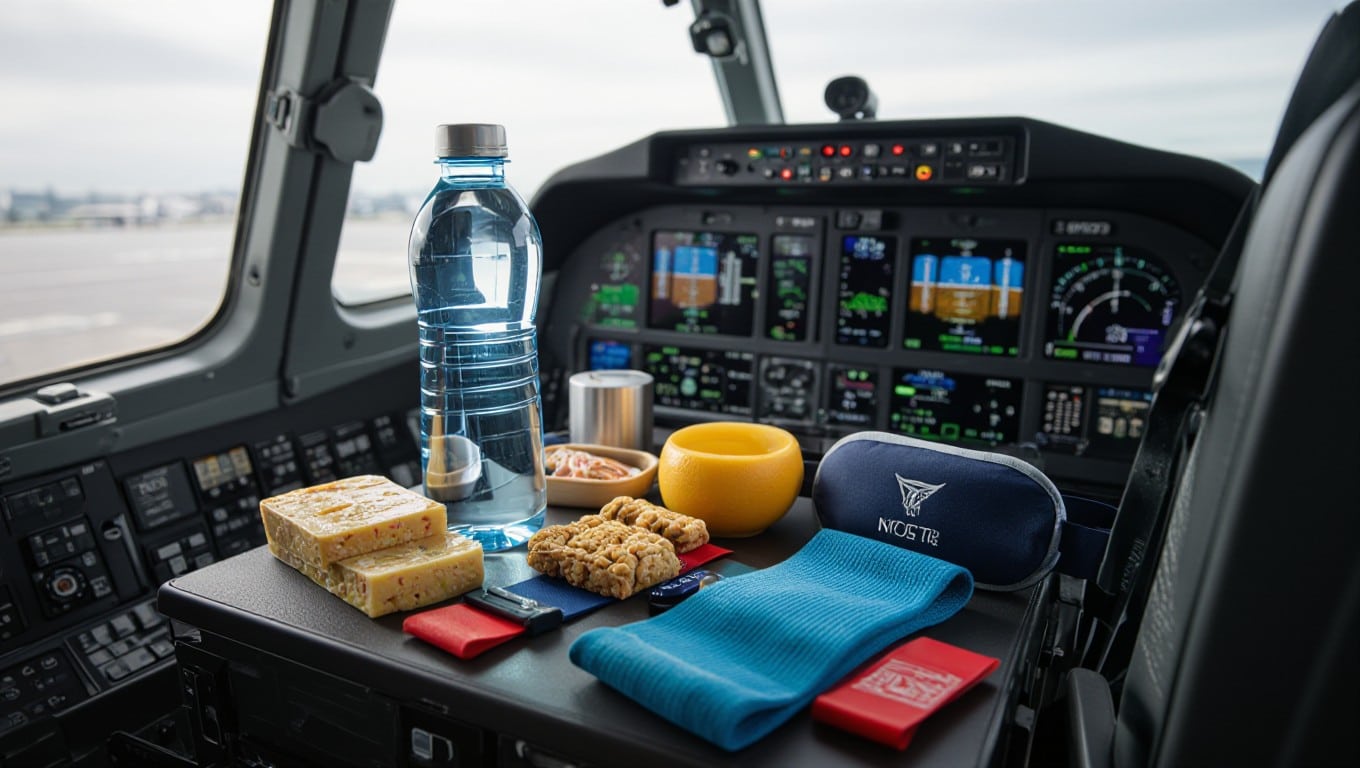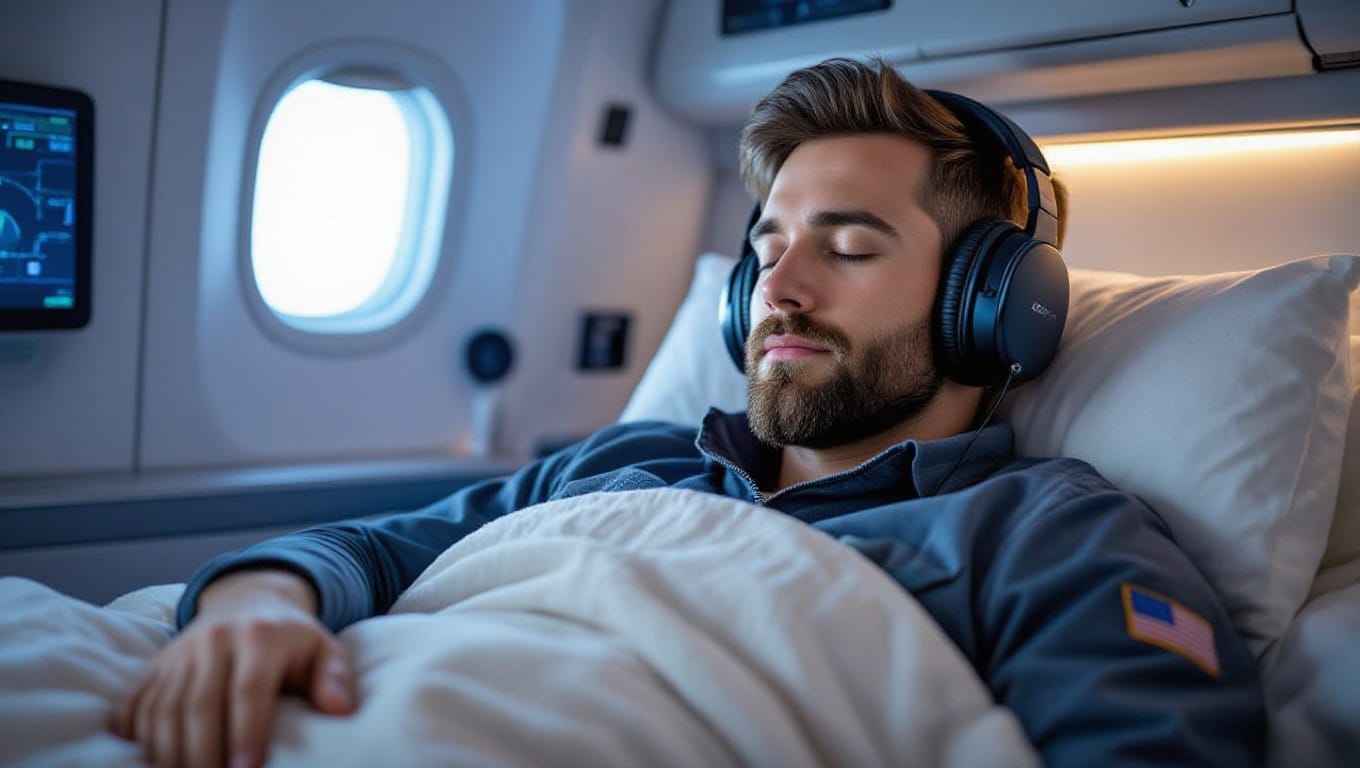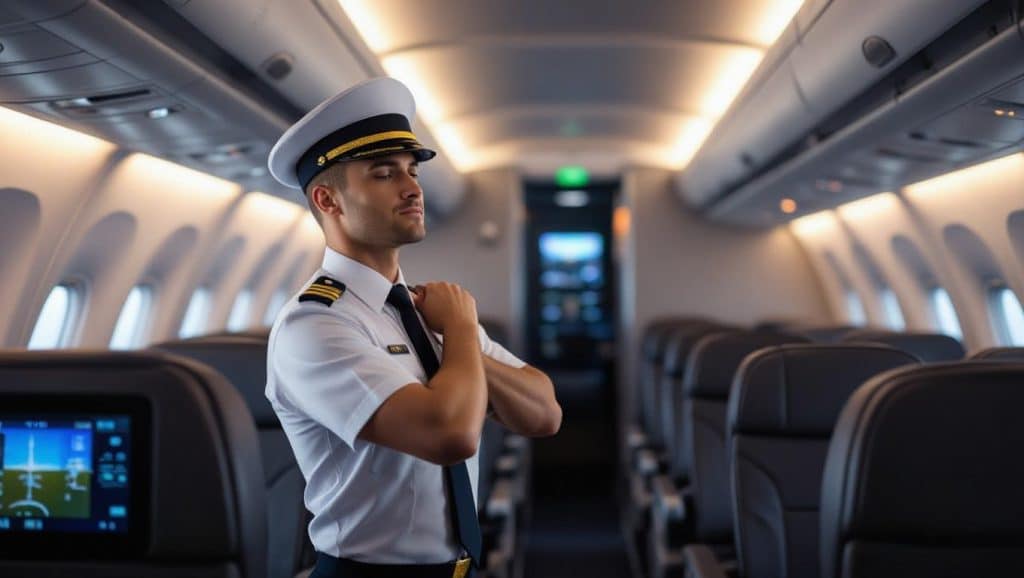Pilot Lifestyle Insights
Pilot Health Tips: Staying Fit on Long-Haul Flights
There’s no denying that long-haul flights pose unique physical challenges for pilots, from dehydration and fatigue to the risks of deep vein thrombosis. To maintain your operational efficiency and overall well-being, adopting effective hydration practices, nutrition strategies, and simple in-flight exercises is crucial. Backed by expert advice and medical research, these pilot health tips will help you stay alert, fit, and healthy, ensuring you perform at your best during those extended duty periods.
Top 5 Pilot Health Tips for Long-Haul Flights
- Stretch Frequently: Move every 1–2 hours to improve circulation and reduce stiffness.
- Stay Hydrated: Drink at least 250ml of water every hour in the air.
- Eat Light and Clean: Opt for lean proteins and complex carbs, avoid heavy or processed meals.
- Manage Sleep Wisely: Use sleep masks, earplugs, and time your rest around destination time zones.
- Use Crew Rest Effectively: Follow a recovery routine post-flight to reset your circadian rhythm.
Combatting Cabin Pressure: Strategies for Optimal Hydration
The low humidity and reduced cabin pressure at cruising altitudes accelerate fluid loss through skin and respiration, leaving pilots vulnerable to dehydration symptoms like headaches, fatigue, and impaired concentration. To maintain operational efficiency, adopting targeted hydration strategies tailored to long-haul environments helps mitigate these risks. Understanding how much and when to drink fluids can enhance both physical comfort and cognitive performance during prolonged flights.
The Importance of Staying Hydrated
Dehydration in flight can reduce your cognitive sharpness by up to 13%, directly impacting decision-making and reaction time. Since the pressurized cabin air typically holds less than 20% humidity compared to ground levels of 30–60%, your body loses water faster than usual. Maintaining adequate hydration supports cardiovascular function, sustains alertness, and minimizes headaches—imperative factors for safe cockpit performance throughout long duty periods.
Effective Hydration Techniques During Flights
Sipping water steadily, aiming for approximately 250–300 ml per hour, prevents abrupt fluctuations in hydration status. Avoiding caffeine and alcohol limits diuretic effects that exacerbate fluid loss. Incorporating electrolyte-rich beverages or oral rehydration solutions helps replenish critical minerals lost through perspiration and respiration, further optimizing hydration without overloading your system.
Extending hydration beyond water, consuming drinks with balanced electrolytes—such as sodium and potassium—supports cellular function and fluid retention. Studies from aerospace medicine experts recommend using electrolyte powders or fortified waters to maintain plasma volume and reduce muscle cramps during extended flights. Setting reminders every 30–45 minutes to take small sips can counteract natural tendencies to drink less while focused on flight duties. Additionally, pairing hydration with light in-flight movement improves circulation, enhancing overall water absorption and reducing swelling in your lower limbs. This integrated approach empowers you to sustain peak physical and mental condition throughout multi-hour flights.
Navigating Time Zones: Mastering Your Circadian Rhythm
Adjusting your circadian rhythm on long-haul flights demands strategic exposure to light and controlled sleep timing. Studies show timed bright light therapy can shift your internal clock by up to one hour per day, helping you align more quickly with the destination timezone. You can leverage this by planning your light exposure and darkness around your target schedule—wear blue-light blocking glasses to avoid premature shifts and seek sunlight outdoors immediately upon arrival. These measures reduce the risk of persistent jet lag, improving both alertness and decision-making during critical flight operations.
Sleep Strategies Before and After Flights
Optimizing sleep around flights involves progressively adjusting your sleep window to the destination time at least 24 to 48 hours ahead. Short, controlled naps before departure can reduce accumulated fatigue without impairing night sleep. Post-flight, aim for exposure to natural light during the day and avoid heavy meals or caffeine close to bedtime to support restorative sleep. Research demonstrates that consolidating sleep according to the new timezone minimizes cognitive impairment during subsequent duty periods.
In-Flight Adjustments to Minimize Jet Lag
During the flight, managing hydration takes priority—dehydration exacerbates fatigue and jet lag symptoms, so aim for at least 250 ml of water every hour. Light physical activity, such as periodic stretching or walking the aisle, enhances circulation and reduces discomfort. Align your in-flight sleep with your destination’s night hours, using eye masks and noise-cancelling devices to create a conducive environment. These practical steps combined decrease jet lag severity, enabling faster recovery.

Fueling the Body: Nutrition Essentials for Pilots
Long-haul flights demand a steady supply of energy and mental clarity, making balanced nutrition a cornerstone of pilot health. Prioritize meals rich in complex carbohydrates, lean proteins, and healthy fats to sustain focus and prevent energy slumps. Incorporating foods high in antioxidants—like berries and nuts—can help combat oxidative stress commonly experienced during extended time zones. Avoiding excessive caffeine and heavy meals minimizes digestive discomfort and dehydration risks in the pressurized environment. Thoughtful meal choices directly enhance your alertness and physical resilience during those critical flight segments.
Meal Planning for Long-Haul Flights
Design your inflight meal strategy around timing and nutrient density to maintain consistent energy levels. Smaller, frequent meals packed with fiber and protein—such as quinoa salads, grilled chicken, and mixed vegetables—aid digestion and blood sugar stability. Preloading your tray with hydration-heavy fruits, like watermelon or oranges, supports fluid balance, while steering clear of salty or processed foods reduces bloating and fatigue. Optimizing your meal schedule also aligns with circadian rhythm adjustments, improving sleep quality post-shift and enhancing recovery.
Smart Snack Choices that Boost Energy
Choosing snacks that combine protein, healthy fats, and low glycemic carbs offers prolonged energy without rapid blood sugar spikes. Almonds, Greek yogurt with chia seeds, or hummus with sliced veggies serve as practical snacks easily stored in your flight bag. Including foods rich in magnesium—like pumpkin seeds or dark chocolate—can alleviate muscle tension and promote relaxation during high-stress phases. Selecting nutrient-dense options keeps your brain sharp and body responsive throughout marathon flights.
Snacking smartly involves more than just convenience; studies show that incorporating low-GI snacks with protein and healthy fats stabilizes blood glucose, reducing cognitive decline linked to energy dips. For example, a 2018 study in the Journal of Aviation Medicine found pilots consuming mixed macronutrient snacks reported better concentration during complex tasks. Planning snacks with ingredients such as walnuts—rich in omega-3 fatty acids—and raw veggies not only enhances satiety but also supports cardiovascular health, particularly beneficial under inflight stress conditions. Preparing a variety of these snacks ensures availability regardless of inflight catering limitations.
Movement Matters: In-Flight Exercise Routines
Keeping your body active during long flights can significantly reduce stiffness and fatigue. Incorporating brief, targeted movements within the confined cockpit or cabin space helps maintain muscle tone and joint flexibility. Studies show that even mild activity during lengthy flights lowers the risk of deep vein thrombosis (DVT) and enhances alertness. A routine combining stretching, ankle rotations, and light resistance exercises can seamlessly fit into your breaks, improving circulation and overall comfort during extended duty periods.
Simple Stretches to Alleviate Tension
Performing gentle neck rolls, shoulder shrugs, and seated spinal twists eases tension accumulated from prolonged sitting and cockpit posture. These stretches increase blood flow and reduce muscle tightness, focusing on areas prone to stiffness like the neck, upper back, and hips. Each stretch should last about 20-30 seconds to effectively release muscle tension without interrupting flight duties.
Airplane-Friendly Workouts to Enhance Circulation
Leg lifts, ankle pumps, and seated marches are effective in promoting blood flow and preventing swelling during long-haul flights. Engaging calf muscles through repetitive flexing and pointing motions stimulates the venous system, helping to minimize discomfort and reduce risks associated with prolonged immobility. These simple exercises can be done discreetly and frequently throughout your flight.
Adding resistance bands or using your body weight for isometric exercises—like pressing feet into the floor or tightening glute muscles—further boosts circulation without requiring extra space or equipment. According to research published by the Aerospace Medical Association, performing these routine movements every 30-45 minutes significantly lowers the incidence of lower limb edema and circulatory complications amongst aircrew. Incorporate these airplane-friendly workouts systematically to maintain optimal vascular health and reduce fatigue on extended international routes.
The Psychology of Fatigue: Mental Wellness on Long Flights
Extended flights challenge your cognitive stamina as much as your physical endurance. Mental fatigue can subtly impair decision-making, reaction time, and situational awareness, increasing operational risk. Research published in the Aviation, Space, and Environmental Medicine journal highlights that pilots performing long-haul flights show a notable decline in psychomotor vigilance after just 8 hours. Managing your psychological state through proactive strategies helps maintain sharpness, ensuring your performance remains reliable throughout the flight.
Recognizing Signs of Fatigue and Stress
You might notice delayed responses, difficulty concentrating, or irritability as inner signals of fatigue and stress accumulation. Physical manifestations like headaches, heavy eyelids, and muscle tension often accompany these mental signs. Studies find that self-awareness of these symptoms enables pilots to take timely breaks or engage in mitigation techniques before performance degradation impacts flight safety.
Techniques for Maintaining Focus and Alertness
Changing cockpit tasks at regular intervals, engaging in brief cognitive exercises, and controlled breathing methods help sustain your alertness during long flights. Incorporating short, active microbreaks with in-seat stretches or walking if possible stimulates circulation and brain function, countering the sedative effect of prolonged sitting and low cabin pressure.

To wrap up
From above, implementing effective pilot health tips can significantly enhance your well-being during long-haul flights. By prioritizing hydration, managing fatigue with strategic rest, maintaining balanced nutrition, and incorporating simple in-flight exercises, you support both your physical health and operational performance. Research indicates these practices help reduce risks associated with extended duty periods. Adopting these strategies empowers you to stay alert, comfortable, and fit throughout your flights, ultimately contributing to safer and more efficient operations.
Frequently Asked Questions About Pilot Health on Long-Haul Flights
How can pilots stay physically active during long flights?
Pilots can perform light stretching in the cabin or galley, move around regularly when not at the controls, and use resistance bands or seated isometric exercises to maintain circulation and flexibility.
What foods help pilots stay energized during flights?
Focus on protein-rich meals, complex carbohydrates, and hydration. Avoid sugary snacks and heavy meals that promote drowsiness. Nuts, yogurt, fruit, and lean meats are ideal.
How can pilots reduce the effects of jet lag?
Adapt sleep schedules before departure, use light exposure strategically, stay hydrated, and consider short naps. Melatonin supplements may help, but always consult aviation medical guidance first.
Are there specific exercises pilots can do in the cockpit?
Yes—neck rolls, shoulder shrugs, ankle circles, and core contractions can all be performed seated during cruise. These help prevent muscle tension and poor posture during long periods of sitting.
What are key health risks for long-haul pilots?
Common risks include deep vein thrombosis (DVT), dehydration, musculoskeletal strain, chronic fatigue, and disrupted circadian rhythms. Proactive routines and airline wellness policies help reduce them.

